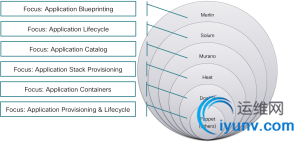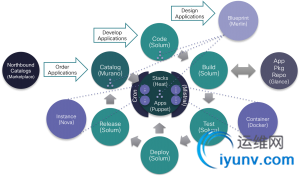|
|
Cloud infrastructure is useless without applications running atop, providing business servi
 cesand solving customer needs. So, as applications ascend to the throne as the rightful king of cloud, focus sharpens on their support within OpenStack-based clouds. With this focus, let’s walk through a survey of components and projects supporting applicationsin OpenStack, understanding what a day in the life of an application in OpenStack is like. We’ll start with an overview of the application ecosystem comprised of a number of supporting projects. In the ecosystem overview below, relevant OpenStack projectsare presented in context of existing, similar technologies with which you may be familiar. These similar technologies both under and overlap functionality of the respective OpenStack project, but are shown to hasten your general understanding of which bucketthese projects fall into by way of tech you may already know (so, add a pinch of salt when considering relevancy of suggested affiliated technologies).
cesand solving customer needs. So, as applications ascend to the throne as the rightful king of cloud, focus sharpens on their support within OpenStack-based clouds. With this focus, let’s walk through a survey of components and projects supporting applicationsin OpenStack, understanding what a day in the life of an application in OpenStack is like. We’ll start with an overview of the application ecosystem comprised of a number of supporting projects. In the ecosystem overview below, relevant OpenStack projectsare presented in context of existing, similar technologies with which you may be familiar. These similar technologies both under and overlap functionality of the respective OpenStack project, but are shown to hasten your general understanding of which bucketthese projects fall into by way of tech you may already know (so, add a pinch of salt when considering relevancy of suggested affiliated technologies).
Application Ecosystem by Project
Like individual lines in a product family, projects within OpenStack engulf and extend one another for related, but distinct purposes and target use cases. OpenStack developers are cautious to apply DRY principles in their approach to project design, integratingfunctionality rather than reinventing the wheel as they go. The ProjectFocus and Relationship diagram both figuratively and literally places project relationships into round bubbles, identifying conceptual starting points for the genesis of an application as well as the reuse of some projects by others.
- ApplicationBlueprint Designer – Merlin
- RavelloSystems, UrbanCode, CliQr, Prime Service Catalog*…
- ApplicationLifecycle Management PaaS – Solum
- Similar technologies (ALM) – Atlassian Suite, HP ALM, Cloudpipes, Serena…
- Similar technologies (PaaS) – Openshift, Cloud Foundry, BlueMix, AppScale, Heroku, App Engine…
 Project Focus and Relationship
Project Focus and Relationship
- ApplicationCatalog – Murano
- Similar technologies – AppStack, CliQr, ITApp, AppDirect…
- ApplicationStack Provisioning –Heat, Magnum
- Similar technologies – AWS Elastic Beanstalk, Kubernetes, GearD, Warden, Fleet, MaestroNG, CliQr, Nirmata…
- ApplicationContainers – Docker
- Similar technologies – OpenVZ, Linux V-Server, FreeBSD jails, AIX Workload Partitions and Solaris Containers
- ApplicationConfiguration Management – Puppet, Chef
- Similar technologies – Heat, Salt, Ansible, Satori*…
A Day in the Life of an OpenStack-Native Application
The ApplicationLifecycle Flows diagram defines different entrance points by which applications are birthed and the flow between different OpenStack projects within their lifecycle.
Application Lifecycle Flows
Users may design applicationswith Merlin, develop applicationswith Solum, orderapplicationswith Murano, deploy applicationsand resources with Heat and manage applicationswith Puppet/other configuration managers.
“Applications”
Given that applications are varied in nature both in terms of their type and complexity, let’s take a moment to review their possible shapes and sizes. With regard to types of applications, some are image-based and some are container-based while othersare offered simply as a SaaS subscription (implying that a singular instance of this application may serve multiple tenants). Applications may be cloud-native (designed to be scaled out, highly distributed, service-oriented) or enterprise-architected (designedto be scaled up, designed with layers and functional domains). Application complexity ranges from single component (image or container) to multiple component, multiple environment, multiple OpenStack deployments to OpenStack and other systems. Applicationsmay be comprised of multiple components (e.g. MySQL, PHP, Apache) or a singular components (MySQL). Application components may be distributed or contained within a given container, VM or cloud. With these possibilities in mind, let’s begin our survey of theirsupport with the OpenStack-native application catalog – Murano in the next post in this series.
from: http://blog.gingergeek.com/2014/11/going-native-with-openstack-centric-applications-overview/
GoingNative with OpenStack Centric Applications: Murano http://blog.gingergeek.com/2014/11/going-native-with-openstack-centric-applications-murano/?utm_campaign=899&utm_medium=twitter&utm_source=twitter&utm_campaign=OpenStack+Now&utm_source=hs_email&utm_medium=email&utm_content=15033090&_hsenc=p2ANqtz-8btYZqIYYHnVdCDvMG1XFFZA1uQnkdJmZKYUtuqZMJCNrLN8EWrIinmMuxLoo6xWQlylXIqsX3Z68PpSy_BL1HCCNzCQ&_hsmi=15033090 |
|